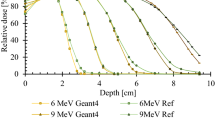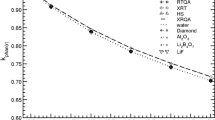Abstract
This study presents Monte Carlo-calculated absolute and normalized (relative to a 60Co beam) sensitivity values of silicon diode dosimeters for a variety of commercially available silicon diode dosimeters for radiotherapy photon beams in the energy range of 60Co–24 MV. These values were obtained at 5 cm depth along the central axis of a water-equivalent phantom of 10 cm × 10 cm field size. The Monte Carlo calculations were based on the EGSnrc code system. The diode dosimeters considered in the calculations have different buildup materials such as aluminum, brass, copper, and stainless steel + epoxy. The calculated normalized sensitivity values of the diode dosimeters were then compared to previously published measured values for photon beams at 60Co–20 MV. The comparison showed reasonable agreement for some diode dosimeters and deviations of 5–17 % (17 % for the 3.4 mm brass buildup case for a 10 MV beam) for some diode dosimeters. Larger deviations of the measurements reflect that these models of the diode dosimeter were too simple. The effect of wall materials on the absorbed dose to the diode was studied and the results are presented. Spencer–Attix and Bragg–Gray stopping power ratios (SPRs) of water-to-diode were calculated at 5 cm depth in water. The Bragg–Gray SPRs of water-to-diode compare well with Spencer–Attix SPRs for ∆ = 100 keV and above at all beam qualities.

Similar content being viewed by others
References
Ellen Y, Rodica A, Li D, Doracy F, Andre K, Darryl K et al. AAPM Task Group No. 87 Report: Diode In vivo Dosimetry for Patients receiving external beam radiation therapy. 2005.
Rickner G, Grusell E. General specifications for silicon semi conductors for use in radiation dosimetry. Phys Med Biol. 1987;32:1109–7.
Rickner G, Grusell E. Effects of radiation damage on p-type silicon detectors. Phys Med Biol. 1983;28:1261–7.
Saini AS, Zhu TC. Energy dependence of commercially available diode detectors for in vivo dosimetry. Med Phys. 2007;34:1704–1.
Kawrakow I, Mainegra-Hing E, Rogers DWO, Tessier F, Walters BRB. NRCC Report PIRS–701: The EGSnrc Code System: Monte Carlo simulation of electron and photon transport., National Research Council of Canada, Ottawa, Canada, 2010. Available from http://www.irs.inms.nrc.ca/EGSnrc/pirs701.pdf.
Verma D, Palani Selvam T, Arun C, Munshi P. Comment on “Energy dependence of commercially available diode detectors for in vivo dosimetry” [Med. Phys. 34, 1704–11 (2007)]. Med Phys. 2010;4517–9.
Rogers DWO, Kawrakow I, Seuntjens JP, Walters BRB, Mainegra-Hing E. “NRC User Codes for EGSnrc”, NRCC Report PIRS-702 (revB). Ottawa: National Research Council of Canada;2010.
Kalach NI, Rogers DWO. When is an accelerator photon beam “clinic-like” for reference dosimetry purposes. Med Phys. 2003;30:1546–55.
Mohan R, Chui C, Lidofsky L. Energy and angular distributions of photons from medical linear accelerators. Med Phys. 1985;12:592–7.
Lesley B. Carleton University PhD Thesis: An EGSnrc investigation of correction factors for ion chamber dosimetry. 2005. Available from http://www.physics.carleton.ca/~drogers/pubs/theses/Buckley_PhDthesis05.pdf.
Saini AS, Zhu TC. Temperature dependence of commercially available diode detectors. Med Phys. 2002;29:622–30.
Saini AS, Zhu TC. Dose rate and SDD dependence of commercially available diode detectors. Med Phys. 2004;31:914–24.
Saini AS, Zhu TC, Rebo I. Dosimetric evaluation of new n-type Pt-doped QED diode detectors. Med Phys. 2003;30:1479.
Palani Selvam T, Rogers DWO, Inclusion of Bragg–Gray stopping-power ratios in the EGSnrc user-code SPRRZnrc, Report CLRP 06-01, Carleton University, Ottawa. 2006 Available from http://people.physics.carleton.ca/~drogers/pubs/papers/bgspr.pdf.
Attix FH. Introduction of radiological physics and radiation dosimetry. New York: Wiley;1986.
ESTAR-NIST database (http://physics.nist.gov/PhysRefData/Star/Text/ESTAR.html).
Acknowledgments
The authors thank Dr. Y.S. Mayya, Head, Radiological Physics and Advisory Division, Bhabha Atomic Research Centre (BARC), and Dr. A.K. Ghosh, Director, Health, Safety and Environment Group, BARC, and Dr. G. Chourasiya, BARC for their encouragement and support throughout this project.
Author information
Authors and Affiliations
Corresponding author
About this article
Cite this article
Arun, C., Palani Selvam, T., Dinkar, V. et al. Monte Carlo-based energy response studies of diode dosimeters in radiotherapy photon beams. Radiol Phys Technol 6, 151–156 (2013). https://doi.org/10.1007/s12194-012-0181-2
Received:
Revised:
Accepted:
Published:
Issue Date:
DOI: https://doi.org/10.1007/s12194-012-0181-2




